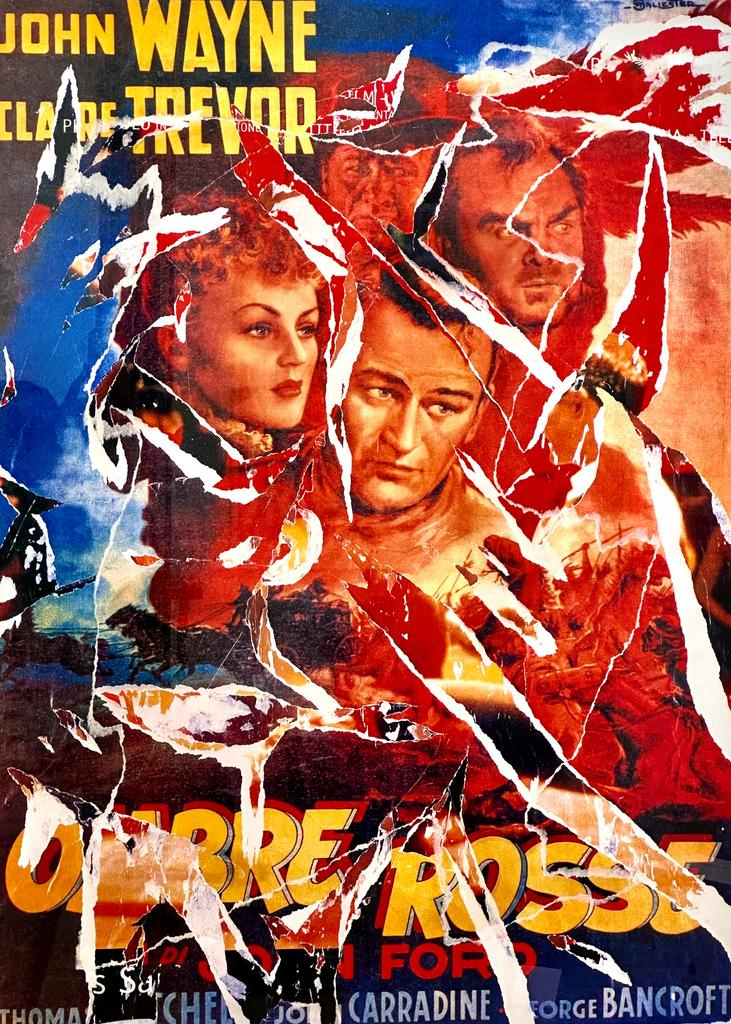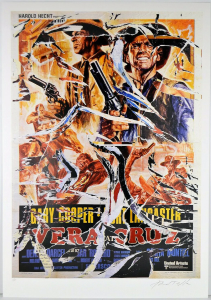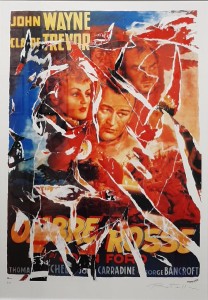Mimmo Rotella was born in Catanzaro on October 7, 1918 from a middle-class family, his mother started a milliner business with 12 workers. After graduating from the Academy of Fine Arts in Naples, in 1945 he moved to Rome where he attended the avant-garde of Roman artists gathered in the Forma I Group. Mimmo Rotella began his artistic career as a figurative painter continuing then as an abstract-geometric painter. In the meantime he experimented with phonetic poetry, which he called epistaltica, and traveled to the United States as artist in residence at the University of Kansas City. Mimmo Rotella returned to Italy in 1954 and settled in Rome where, during a deep artistic crisis, he came to the intuition that advertising posters, whose cities are carpeted, constitute an art form. Thus was born the "décollage" which is the opposite of collage. That is, while the collage operates an overlap of images, the décollage operates a subtraction of the image through tears, and abrasions of the figures. The peculiarity of Mimmo Rotella's work is that he also uses the back of the collage for which the "retro d'affiche" are born. In the first works Rotella uses public billboards by detaching them from their support, generally of galvanized sheet, assembling them on canvas with a few interventions of tears that are not random but performed with deliberate wisdom. 1960 is an important year for Rotella as he adheres to the movement of "Nouveau Réalisme", of which the young critic French Pierre Restany is theoretical, and then because the subjects of his décollage are the most popular characters of Hollywood cinema or that of Cinecittà. Rotella then passes from the abstract of the first décollage to the glossy figurative, gravure style, where those who are the stars par excellence in the popular imagination are exalted, Marylin above all and then Mastroianni, Elvis, the circus tiger, etc. Rotella does not stop, however, at the décollage, in the following years he experiments with the technique of photographic carryover on emulsified canvas commonly called "Mec-Art". This diction means that the work is obtained by mechanical means. At the same time Rotella elaborates the technique of "Artypos". This technique consists of taking the printing start-up scrap evidence of the printers, often consisting of overlapping images, and pasting them on canvas. Sometimes after gluing these canvases are plasticized obtaining a more pleasant and attractive result. In the '70s Rotella experimented with two new techniques, the "Frottage" and the "Effaçage". In the frottage Rotella works with nitro solvents of the images taken from the magazines and then transfers these images, largely discolored, on a sheet of white paper by tracing; on the same sheet also transfers multiple images. In the effaçage Rotella treats with solvents the pages cropped from the magazines for which the image undergoes a discoloration until the disappearance of part of it. Subsequently, these pages are glued on canvas. Rotella keeps these works in the drawer until 2004, the year in which he shows them at our gallery so it is decided to organize an exhibition that is the first ever of this kind of works and that will be inaugurated in December 2005, so shortly before his death. The 80s saw three new experiments by Rotella, namely the "Blanks", the "Sovrapitture" and the "Lamiere". The blanks consist in covering the image with monochrome sheets leaving voids according to the artistic perception of Rotella, the overlays are instead graphic interventions, made with acrylic colors, on the décollage. Finally, the sheets are décollages made directly on the sheet metal support of advertising billboards that often take the form of the back of affiche. Rotella dies in Milan on January 8, 2006 while his exhibition activity is in full swing. During his career, Rotella he participated in various international events such as the Venice Biennales of 1964, 1978 and 2000, the Rome Quadrennial of 1965 and others. Public and private galleries dedicate many exhibitions to him and his works become part of important museums and private collections all over the world.


